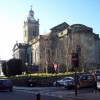For the Reverend Robert Bruce Kennard, his forthcoming marriage to Marie Magdalene Bade in September 1881 was hardly a new experience. After all, he had first tied the knot 33 years earlier when he was wedded to Anne Grace Davis, who bore him no fewer than nine children. Now, the second-time-around the Rector of Marnhull in Dorset was on the eve of another matrimonial union and no doubt in eager anticipation of the happy event for his faithful flock and for him personally. Never in his wildest dreams could he have had any inkling of the bizarre fate that awaiting him next.
Kennard had booked a suite for himself at the Castle Hotel in Woodford, near to the residence of his fiancé, and arrived to heck in at seven o’clock on the evening of the 13th September to prepare for the ceremony the following morning. Having ordered a meal for eight o’clock the minister then retired to his rooms. Later he emerged to discuss the arrangements for carriages to be laid on for the wedding guests in the morning, being especially particular to ensure that the coachmen knew where to call for guests on route.
But there were other guests at the Castle Hotel that evening that did not harbour benign intentions. “A tall, dark man with a heavy moustache and military bearing” in the company of two other men had also checked into the hotel sometime before Robert Kennard’s arrival. Having finished a meal they had ordered, the leader of the party asked a waiter if they could view the rooms upstairs, a request that was complied with. The tall dark man then asked the waiter “if a man by the name of Kennard” was staying at the hotel. Since the waiter had no knowledge of the current reservations his answer was inconclusive.
Downstairs meanwhile, the first man’s collaboration had been in conservation with the barman’s wife. Taken aback to be asked whether there may be another Castle Hotel where Kennard could be found, she went to fetch her husband the landlord, who, considering the men looked entirely respectable, did not take much notice of them. After sitting for a while in the coffee room, the men left the hotel by the London Road. Of course, everyone supposed that they were continuing their journey. In fact, they stopped only a short distance from the hotel to lie in wait for Mr Kennard – evidently with the intention of kidnapping him.
But kidnap him for what purpose? Certainly there was nothing in the clergyman’s background or circumstances that would immediately suggest a motive for such a crime. Like most Anglican clerics of the Victorian period Kennard was a mild-mannered and charitable parish priest with the best interests of his parishioners at heart. Born in 1824 Kennard had been rector at Wymondham in Norfolk before being appointed rector of Marnhull in 1858. His first wife Ann had died on New Year’s Day 1878, leaving the vicar a widower with his children to support or be supported by. With a flair for writing and not one to be idle during his widowhood and latter years, Kennard was to publish a number of books including a translation of Gray’s Elegy into Latin, and even ventured into stock-farming, building up a collection of pedigree dairy shorthorns.
Kennard had been back in his rooms about half an hour when a man called at the hotel stating he had come from a Mr Frazer of Buckhurst Hill, a brother-in-law of the minister. The waiter escorted the man to Kennard’s rooms and a few minutes later the service bell was rung: Kennard asked that his evening meal be put back half an hour as he had been called away for a short time, though he did not specify where he was going. The two men left the hotel together and disappeared into the night.
By three o’clock the following morning Robert Kennard had still not returned to the Castle Hotel. Having waited up for him the landlord came to the conclusion that the minister must have decided to stay the night at a friend’s house. In the morning, preparation of the carriages for the wedding party was proceeding as normal when one of Kennard’s sons arrived and was shocked to find that his father had gone missing.
The son’s immediate response was to telegraph enquiries, the wedding party all the while proceeding to the church in the expectation of finding the clerical bridegroom there. Thoroughly alarmed when Kennard still had not turned up at the church by midday, the guests returned home. However, the minister did arrive at the church about an hour later. Finding no wedding guests, who presumed the ceremony to be cancelled in his absence, he hurried to Woodford rectory for an urgent consultation with the vicar, the Revd. A. Hughes.
Hughes must have heard out the fatigued, overwrought minister’s story with shocked incredulity. Robert Kennard had simply been too polite to return a rough, sceptical answer to the messenger purporting to come from his brother-in-law. Having thus been lured away from the hotel on the pretext of a bogus message about his relative, he was ushered into a waiting carriage. Another man climbed in after the first, while another man was on the driving box. The carriage moved off, but not in the direction of York Villas, the home of the bride–to-be Miss Bade. Instead the coach was heading in the direction of London.
Once the minister realised that the coach was not heading for York Villas and that he was a virtual prisoner, he panicked and began to remonstrate with the driver, but was restrained by being seized by the throat and silenced by the men in the compartment with him. Kennard’s abductors then told him he was not being taken for his money or goods; that robbery was not their intention, though they did not then confide what their motive was. However, at one point the cleric managed to through his hat out of the window in the hope that it could lead searchers to wherever he was being taken.
On arriving in London Kennard again tried unsuccessfully to call for help. The coach stopped at 41 Hunter Street, Brunswick Square and again the minister struggled to break free of his captors while being bundled into the house, but bystanders did nothing to help or raise the alarm. He was taken to a pokey back room in which there were two beds evidently prepared in advance for the night. Kennard, Kennard then passed a sleepless night in agitation, reflecting on the perilous situation he now found himself in. During these dreadful hours of darkness he heard knocks at the front door and then voices outside, evidently a conversation between his captors and some confederates. At dawn the man who at first brought Kennard the bogus message entered the room and threw himself on the other bed without undressing.
Desperate to secure his liberty, the minister then bribed the messenger, first with £5. He then wrote a telegram to Woodford: “Unavoidably detained. Will explain all in a few hours.” Kennard then gave the second man a further £1 to cover the cost of sending the telegram (in fact it was never sent.) On being offered another £5 the messenger then consented to release Robert Kennard unharmed onto the streets of London, whereupon he caught a cab to Liverpool Street Station to catch the next train back to Woodford.
And so did Kennard, upon his arrival at Woodford, come to be just one hour late for his own wedding. Having related the full facts of his unnerving experience to Revd. Hughes he went straight to York Villas and into the welcoming arms of Marie Bade, who had been entertaining Canon Duckworth of Westminster and other friends of Marnhull’s Rector. Duckworth had been appointed to conduct the marriage ceremony and had arrived at the house with the other friends for the wedding breakfast. By a curious twist however, the Canon’s official duties at the abbey had detained him too late for the scheduled time Kennard’s marriage was to have taken place.
Later that morning the Cannon returned to the Castle Hotel with Kennard to stay the night with him there. At eight o’clock the following morning, a Thursday, and with the assistance of Hughes, Duckworth solemnised the wedding of Robert B. Kennard and Marie Magdalene Bade in Woodford parish church. Curiously, Cannon Duckworth later found it necessary to send a letter to the editor of The Standard, correcting a mistake that had been published about the timing of the marriage: “Sir, in your report of the extraordinary abduction of the Revd. R.B. Kennard there is one inaccuracy it is important to correct. Mr Kennard’s marriage, which was so strangely prevented on Wednesday, took place not on Friday but on Thursday morning. I married him in Woodford Church on that day at eight o’clock on the earliest moment after his escape at which the wedding was legally possible.”
One Robert Kennard had returned to Woodfood and placed the matter in the hands of the police, who managed to trace the perpetrators and keep the minister informed of developments. It’s a strange story, and one that over the century following the event has thrown up several conspiracy theories as to what could have led to the kidnap of a respected and well-loved clergyman.
It was never considered a possibility that the incident had had anything to do with Marie Bade. She was German by birth at a time of Franco-German hostility, the daughter of a Charles Bade of Bremen, and the circumstances in which she met Kennard were certainly unusual and rather obscure. Instead, suspicion fell upon members of Kennard’s own inner circle. One theory was that the kidnap had been nothing more than an extremely overplayed practical joke perpetrated in order to delay the wedding. Then there was a rumour circulating in the village at the time that the abduction was concocted by one or more of the minister’s sons or relatives out of covetousness for Kennard’s wealth and the belief that Miss Bade might be the sole beneficiary in the event of his death. Indeed, he was wealthy, a touch eccentric and about to wed a woman much younger than himself. It was thought that, at considerable personal risk, some of the minister’s family may have wanted to have him kidnapped and imprisoned for a period in order to humiliate him and prevent his marriage. Those most interested in the disposition of Kennard’s estate, it is surmised, may have resolved to interfere by putting him out of the way in the expectation that, once his marriage was delayed, it could never afterwards take place. Possibly the abductors were criminals hired to carry out the job, though the amazing thing is that they should have been able to pull off such a daring and foolhardy plan.
The matter was duly referred to the civil courts. Apart from being thoroughly roughed up and traumatised by his experience Robert Kennard was able to resume a normal life soon enough. After the wedding the couple honeymooned at Windsor, and the minister went on to enjoy another fourteen years of productive life in the service of the parish. In 1882, less than a year after his kidnap and re-marriage, he restored the chancel of St. Gregory’s, Marnhull at his own expense, and in 1884 bought the Nash Court estate. He built up his fine herd of pedigree shorthorns, one of which, “Queen Mary,” came to be an unbeaten champion of the show ring. He published The Subversion of the Constitution (an indictment of the admission of Jews into Parliament) besides the Latin version of Gray’s Elegy.
Robert Bruce Kennard died in 1895 aged 71. His son Stanley, who did not live at Nash Court but at Orchard House, sold off his father’s estate in 1921.



